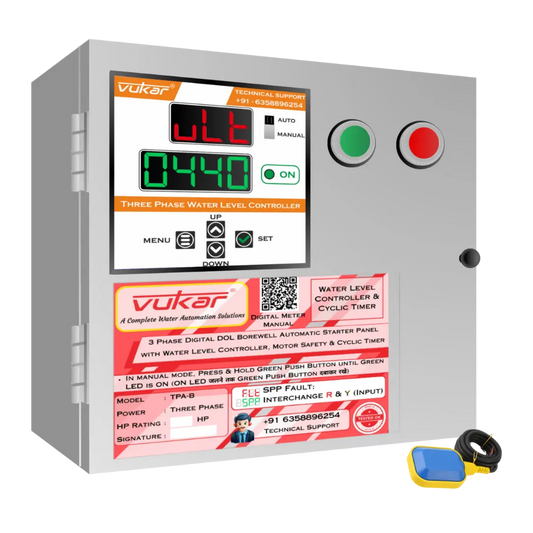3 phase submersible motor starter: A Complete Guide to Selection and Use
Mohit Vekariaशेयर करना
Choosing the right 3 phase submersible motor starter is crucial for ensuring efficient and safe operation of submersible pumps, especially in irrigation, water supply, and industrial applications. A 3 phase submersible motor starter not only helps in starting the motor smoothly but also protects it from electrical faults like overloads and phase failures. Whether you are looking for a 7.5 hp submersible pump starter or a more robust solution for commercial use, understanding its types, sizing methods, connection procedures, and practical applications will help you make an informed decision. This guide covers everything you need to know about selecting and using a 3 phase submersible motor starter effectively.
Understanding 3 Phase Submersible Motor Starter Basics
What Is a 3 Phase Submersible Motor Starter?
A 3 phase submersible motor starter is an electrical device designed to start, control, and protect three-phase submersible motors used primarily for water pumping. It facilitates starting the motor by reducing the starting current and protects against faults such as overload, phase failure, and short circuits.
Key Components of the Starter
Typical 3 phase pump starter units include the following components:
- Contactor: Controls power supply to the motor.
- Overload relay: Protects motor from excess current draw.
- Control circuit: Provides switching and protection functions.
- MCB (Miniature Circuit Breaker): Protects against short circuits.
- Phase failure relay: Monitors power supply phases.
This combination makes sure the motor starts reliably and can be stopped or protected if any electrical fault arises.
Types of 3 Phase Submersible Starters
Direct-On-Line (DOL) Starter
The most common type, DOL starters, connect the motor directly to the power supply. They are simple, reliable, and cost-effective, ideal for motors with ratings up to 7.5 hp or so, making them widely used with standard 7.5 hp submersible pump starter setups.
Star-Delta Starter
Star-delta starters are used for motors requiring reduced starting current. They start the motor in a star configuration, reducing the voltage and current, then switch to delta for normal operation. This is preferred for larger motors to minimize electrical stresses.
How to Size a 3 Phase Submersible Motor Starter
Determining Motor and Load Parameters
Accurately sizing your 3 phase submersible starter involves considering the following:
- Rated motor power (e.g., 7.5 hp, 10 hp, etc.)
- Full load current of the motor
- Starting and running current
- Voltage rating (commonly 415V for three-phase motors)
- Environmental conditions (temperature, availability of cooling)
Guidelines for Starter Selection
- Choose a starter rated for at least 125% of the motor’s full load current for safety.
- Use overload settings aligned with motor specifications.
- Incorporate phase failure and short circuit protection for enhanced reliability.
- Always select starters from reputable manufacturers with certification compliance.
Wiring and Connection of a 3 Phase Submersible Starter
Basic Wiring Overview
The wiring setup for a submersible starter involves connecting the motor leads, power supply, and control circuits properly to ensure smooth operation and protection:
- Three-phase supply wires connect to the starter contactor’s input terminals.
- Output terminals are connected to the submersible pump motor leads.
- Control wiring connects to the starter coil, overload relay, and protection devices.
- Earthing proper is essential for safety.
Important Connection Tips
- Always verify phase sequence to avoid motor damage.
- Use cables of appropriate size matching motor load currents.
- Install isolation switches for maintenance safety.
- Consider including a water-level controller for automated control in pump applications.
Applications of 3 Phase Submersible Motor Starters for Pumps
Common Usage Scenarios
3 phase water pump starters play a vital role in agriculture, residential water supply, commercial buildings, and industrial fluid transfer.
- Irrigation systems: Automated pump control for farms and fields.
- Municipal water supply: Reliable pump operation for clean water distribution.
- Industrial processes: Pumping chemicals, cooling water, or wastewater.
- Domestic water pumping: Borewell and sump pump motor control.
Benefits in Pump Applications
- Prevents motor burnout from voltage fluctuations and dry run conditions.
- Reduces energy consumption by avoiding mechanical stress during startup.
- Extends motor life thanks to overload and fault protection.
- Enables automated and remote control of pumping systems.
Choosing the Right 3 Phase Pump Starter for Your Needs
Key Considerations
- Motor power rating: Ensure starter matches or exceeds the motor size (e.g., 7.5 hp submersible pump starter).
- Protection features: Select starters with overload, phase failure, and short circuit protection.
- Ease of installation and maintenance: Choose starters with clear wiring diagrams and accessible components.
- Brand reputation and certifications: Use trusted brands compliant with standards such as IEC.
Advanced Features to Look For
Modern 3 phase submersible starters may come with digital displays, auto-restart after power failure, dry run protection, and remote monitoring options, adding extra convenience and safety.
Maintenance and Troubleshooting Tips
Regular Inspection Practices
- Check wiring and terminal connections for looseness or corrosion.
- Inspect overload relays and protection devices for proper operation.
- Monitor motor starting patterns and unusual noises.
- Verify motor current and voltage values periodically.
Common Issues and Fixes
- Motor not starting: Check power supply, control circuit, and overload relay status.
- Overheating: Verify starter overload settings and motor load.
- Phase failure indication: Inspect power source and phase monitor relay.
- Frequent tripping: Look for wiring faults, short circuits, or motor defects.
In summary, selecting and using the right 3 phase submersible motor starter is essential for the safety, efficiency, and longevity of your pump motor systems. By understanding the types available, properly sizing and connecting the starter, and applying it thoughtfully to your pumping application, you can prevent downtime and costly repairs. Whether you require a dependable 7.5 hp submersible pump starter or a fully automated 3 phase submersible starter with advanced features, this guide equips you with the knowledge needed to make an informed choice. Explore our selection of certified 3 phase submersible motor starters and enhance your pump system’s reliability today.








